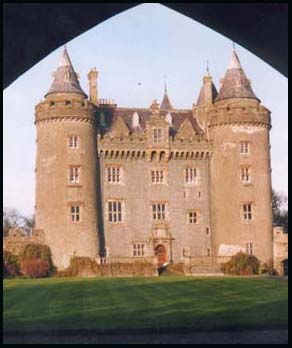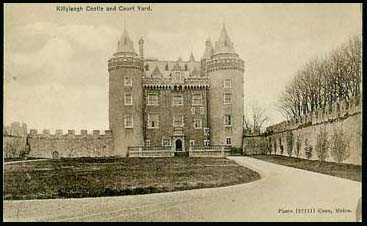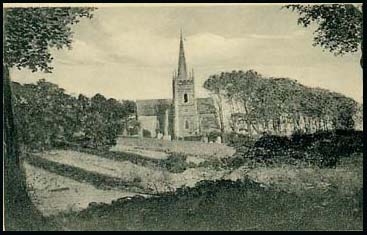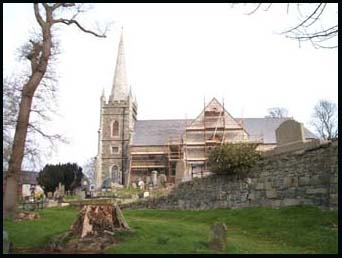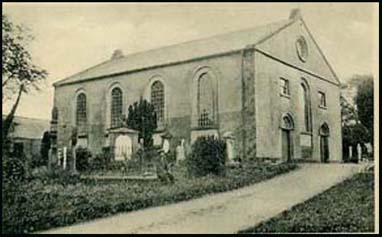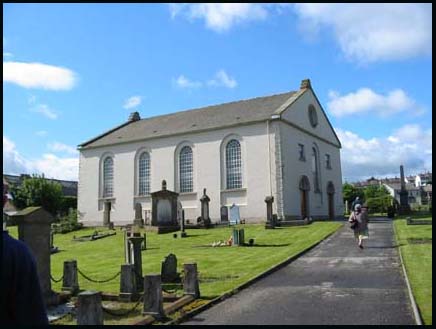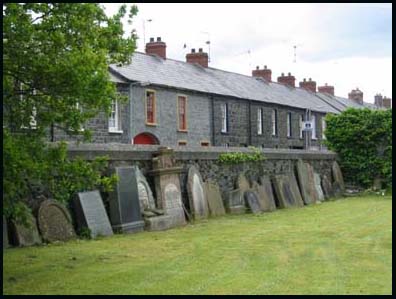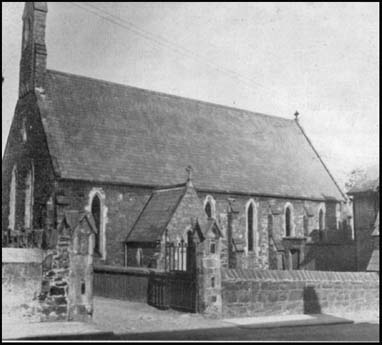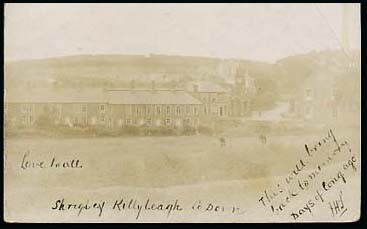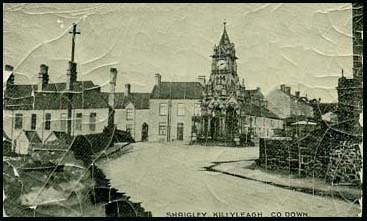|
Ros
Davies' Co.
Down, Northern Ireland Family History Research Site
© Rosalind Davies 2001 Permission granted to reprint research for non-profit use only |
Killyleagh Parish
| Killyleagh town & Castle | . | Killyleagh Castle | Church of Ireland |
| 1st Presbyterian Church | 2nd Presbyterian Church | Wesleyan Methodist Church | Catholic Church |
| Shrigley | . | . | . |
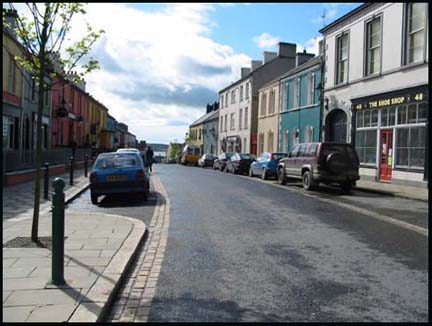 |
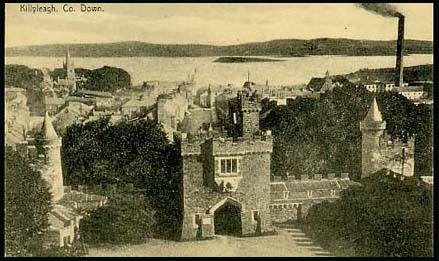 |
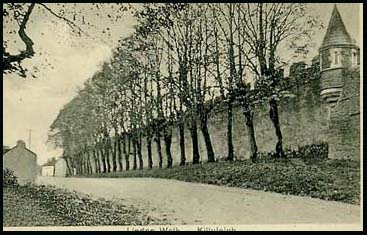 |
| Killyleagh 2005 looking from the Castle gates to Strangford Lough. | This postcard of Killyleagh town dated early 1900s was kindly sent to me by Peggy Isbell of Texas USA. It belonged to her great grandmother Martha Jane Edgar ( nee Shields) of Killyleagh. It shows Strangford Lough in the background with the Castle in the foreground. The spire of the Church of Ireland is visible on top left. |
Another lovely postcard from Peggy Isbell of Texas USA. This one shows Linden Walk - a lovely row of Linden trees along the castle boundary wall. .
|
|
In April 1689 a battle was fought near the town when Col. Talbot of
Cormac O'Neill's Regiment defeated supporters of King William under
Henry Hunter. This battle is known as 'The Break of Killyleagh".
There were ladies' baths- hot & cold, shower or plunge. No baths for gentlemen who were obliged to hire a boat and venture out into the lough. Two major fairs were held every year in May and November. Servants were procured and dismissed at these seasons of the year ( a hiring fair). There was a small market every Friday which was not well attended. The court of Petty Sessions was held once a quarter with 2 or 3 magistrates attending. (Arthur Hill Reed Esq., Mr. Johnston Esq. of Hollypark, and Robert Heron Esq. of Ardville.) There were three policemen in town but there were rarely any "quarrels" . The people in the area mainly relied on agriculture with a little spinning sufficient for their own needs. The people were described as industrious, quiet and independent people. In 1871 there were 1089 Catholic and 4821 Protestant families in the parish. In 1886 there were 2 spinning mills here. There was a Church of Ireland, 2 Presbyterian, 2 Methodist, and a Catholic church & Catholic Parochial House here in 1836, also several schools. Newspaper article from the Northern Star; Newspaper articles from Down Recorder; Newspaper article from Newtownards Independent; Newspaper articles from Newtownards Chronicle; I have indexed the information from the Griffiths Valuations of 1863 for Shore Street, Corporation & 1891-1899 Police Census of the parish into the Surnames Index. There is a DVD for sale "Where Legends are Born" about the history of Killyleagh £10 from www.Dupes.tv |
| References;NS; V17 p 80, 82, 83, 120 & V7 p 95 OSM; OFD p xi; DR & DR* 7/11/2001, 5/11/03; NC; O'L V1 p 409 & B p 492; POD;LR 2005 p20 |
|
||||||
| References;V17 p 81, 83 OSM; DR : O'L V1 p 337; SFSOK p42 |
|
Newspaper articles from Down Recorder; Newspaper articles from Newtownards Chronicle; Records for baptisms and marriages are from 1813, graveyard attached, gravestone inscriptions available UHF Vol 6; email me for a look-up in old graveyard as well. |
| References;V17 p 80, 83 OSM; SFSOK p3; DR ; SFSOK p114,132,136 |
1st Presbyterian Church,
Killyleagh
in Plantation Street
The first minister of the congregation was the blind Rev. Bole in 1639 . The next minister was Rev. William Richardson from 1649 until 1670 then Rev. Alexander Ferguson until 1684 . The earliest Presbyterian church was built on the present site in 1670, and was replaced by a T shaped church in early 1700s. Rev. James Bruce was minister in 1684 until 1730 with some respite in Scotland during the Rebellion. He was suceeded by his son Rev. Patrick Bruce in 1731- 1732. He was succeeded by Rev. Gilbert Kennedy jnr in 1733-1744 then Rev. William Dunn 1745-1765 then Rev. Joseph Little 1768-1813 then Rev. W.H. D. McEwen 1813-1817 then Rev. Henry Cooke 1818-1829. The earlier church was pulled down and in 1827 the new classical edifice was built at a cost of £2,000 which was raised by subscription & contributions. It is in the usual T shape & held 1,050 people with the average attendance in 1836 of 800. It was described in 1836 as a fine , large building with a plain interior. The minister from 1831 - 1882 was Rev. Andrew Breakey but as he became infirm Rev. William Witherow took charge until 1883 & from 1883 was Rev. John R. McCleery. The graveyard is unusually extensive for a Presbyterian church, with a few 18th century stones scattered on all sides of the church, the oldest dating from 1754. The area near the gate was levelled during the 1960s and many stones moved to the graveyard wall. Some stones were destroyed and others uncovered. Newspaper article from Down Recorder; Records available are from 1692; Killyleagh Library holds baptisms
1693-1757 then 1835-1882 & marriages 1692-1760 then 1833-1872; (personal
visits only) North of Ireland FHS (www.nifhs.org) has baptisms 1835-1882
& marriages 1692 -1872; LDS Batch #700311 & M700311 |
||||||||||||
| References;HCPCI p168-169; V17 p80, 83 OSM; Register of Deeds; DR * 10 Dec 1856; MID p 101: GIC; GIPR; LR 2007 p88; POD; RWN p 53; SFSOK p122,123,129 |
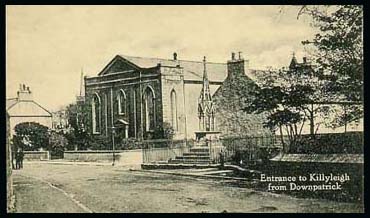 |
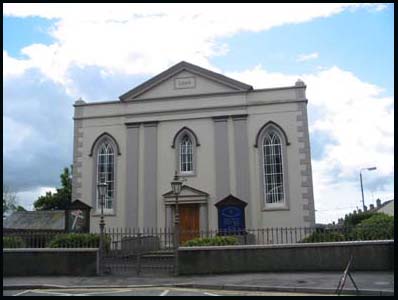 |
|
|||
| This lovely old postcard was kindly sent to me by Peggy Isbell of Texas USA. It shows the 2nd Presbyterian church on the outskirts of Killyleagh entering from Downpatrick direction. |
This photo (above) was taken in 2002
|
||||
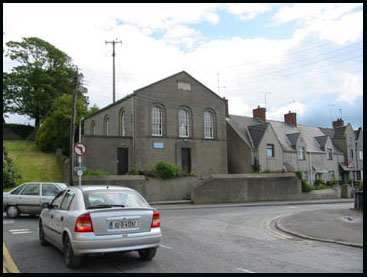 |
|
|
An interesting letter: Dear Reverend Sir, Now, Rev, Sir, my reason for asking these questions are: I lived in Killyleagh in 1824 and part of 1825. I was a tradesman, a builder and foreman to a building company in Dublin, who had a contract for building a steeple and spire to the Protestant church in that town. I was sent there as director and overseer of the works. When I first went to Killyleagh I very naturally asked was there a chapel in it. I was told there was not, nor no nearer than Crossgar. Nor was there a Catholic living in the town but five. And one of them a convert. In a few days I found it to be a fact- there was but five, two men and three women, servant girls, in the town. Of course me and my wife had to go to Crossgar every Sunday to Mass. I was not long going there when I got acquainted with the parish priest, a Rev. Father Curoe, am elderly gentleman, who took compassion on my wife to have to walk every Sunday- there being no car for hire in the town at that time. Father Curoe asked me if he sent a priest to Killyleagh, where he could celebrate Mass. I said he could celebrate Mass in the house I lived in, as I had the house to myself. This was in 1825. Fr. Curoe sent a priest, a Father McMullan , a and a boy with the vestments. The first Sunday he came we had but six of a congregation; the nest time more than the house could contain. There was a Mr. Keon in the town, an agent of the Roan family, and I asked him for the use of the coach-house at the Castle to have Mass celebrated in it, which he very kindly and cheerfully gave to me. We then adjourned to the coach-house, where we had Mass every Sunday after 2 o'clock from the landing of the steps at the hall door of the Castle, and a great many Presbyterians used to come and listen to him (but no Protestants) and very respectable they did conduct themselves and said they would like to hear him. He was a splendid preacher. He preached one Sunday on the events of the Blessed Virgin and he done it every justice and the Presbyterians liked it very much. The Rev. Fr. Curoe told me there was not a Mass celebrated in Killyleagh for upwards of 300 years before it was celebrated in my house. As Father, for the house I lived in, I hope there is a Catholic living in it now; it is the next house to the upper gate going to the church in the back street. One incident more, Reverend Sir, if you please. When I was going to Crossgar to Mass there were a very respectable little chapel in it, and look rather new, but there was no tabernacle and it looked very bare without one on the altar. I got my carpenter to make one- a good one- and we placed it on the altar. It had one fault to it when it was up- it looked rather large for the altar, but , however, we left it so. I suppose it is there still. If it be, Rev. Sir, when you see it think of me and hope, sir, you'll pray fro me. I humbly beg your reverence's pardon for troubling you with such much bad writing, but my sight is failing me fats. I am a very old man. I was born on Easter Sunday, 16th April, 1786 and if God spares me life until next Easter Sunday, it will be on the same date which will finish my 90th year. I would be very happy to know if there does be Mass in Killyleagh and that I was instrumental in commencing so good a work. I remain, Rev. Sir, Your most obedient and humble servant, Martin Lyons Clonmona Cottage, Birr, King's County" ****************** Newspaper article from Down Recorder; |
| References;V17 p80, 83 OSM; PsCIK; DR: KCBp18,19,33; GIC; O'L V1 p 337; LM 1994 p59 , 74 |
|
The village comprised of 137 houses, all built of dressed blue stone
in various sizes. There was River Row, Brick Row, Short Row, Field Row,
Model Row and Bank Row. Martin also proved a cricket field, football
pitch, cycle track, bath house, recreation hall, school, drapery and
grocery store for his employees. He was one of the new breed of 'enlightened'
19th century industrials. The people of the district wanted to commemorate
the contribution John Martin had made to their lives and a competition
was held in 1870 for designs for a clock tower (see above) and drinking
fountain in his honour. |
| References;DR; DR* |
by Ros Davies
